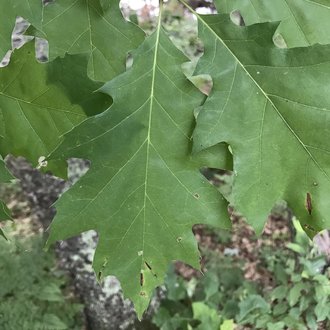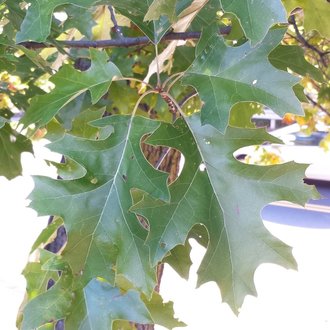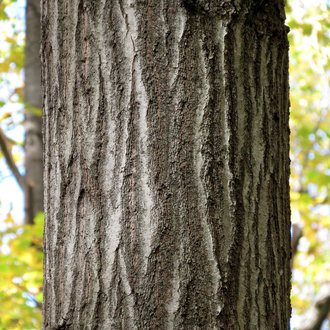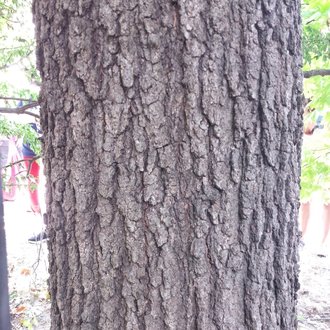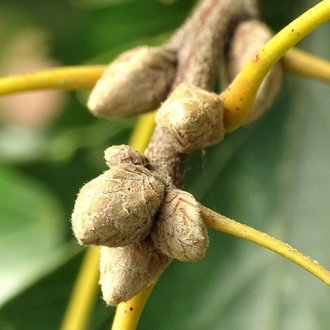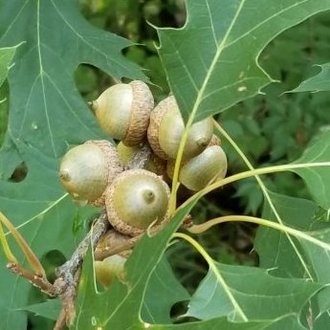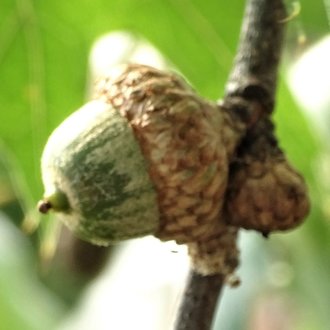Northern Red Oak vs Black Oak
Although these species sometimes look blatantly different, significant variation in individual leaf shape and other characteristics can make them challenging to tell apart. Both trees have broad habitat preferences, with considerable overlap. Black oak ranges farther south and prefers slightly warmer, drier sites, and is more tolerant of nutrient-poor sites, whereas northern red oak ranges farther north, prefers slightly cooler, moister sites, and is more shade-tolerant. The two species can also hybridize and form intergrades, so it may not be possible to identify all individuals.
Northern Red Oak (Quercus rubra) | Black Oak (Quercus velutina) |
A large tree, one of the dominant components of the forests of eastern North America, native to a wide range of the northeastern U.S. and Canada, extending well into the south. | A large oak with a wide distribution across eastern North America, common in much of its range, often a canopy tree in forests. More tolerant of dry, nutrient-poor conditions than most large oaks. |
Leaves typically have 7-11 lobes. Photo © Aaron Boers, CC BY 4.0. | Leaves typically have 5-9 lobes. Photo © Even Dankowicz, CC BY 4.0. |
Bark of mature (but not ancient) trees usually has long, unbroken vertical strips of smooth bark. Cracks between bark are shallow and can be broad, often showing a slight reddish color on close inspection. Photo © Katja Schulz, CC BY 4.0. | Bark is more rugged and fragmented on trees of similar age. Ridges have more horizontal cracks and smaller unbroken pieces. Cracks between outer pieces of bark are deeper and narrower. Outermost pieces of bark are rougher. Photo © Even Dankowicz, CC BY 4.0. |
Mature buds are slightly smaller, and either lack hair entirely, or are only pubescent at the tip. More rounded and less likely to have sharp angles in cross-section. Photo © Leila Dasher, CC BY 4.0. | Mature buds are slightly larger, and are covered in dense whitish hair. Buds look more angular in cross-section. Photo © Shirley Zundell, CC BY 4.0. |
Acorns are larger; cap covers less (1/3rd to 1/4th) of the acorn. Photo © Rob Norris, Public Domain. | Acorns are smaller; cap covers half or nearly half the acorn. Photo © Shirley Zundell, CC BY 4.0. |
Leaves of seedlings in shade often more oval-shaped, with widest point closer to the middle of the leaf, and a taper towards the tip. Glabrous (lacking hairs) except possibly a few tufts of hair in vein axils on underside. Not usually shiny, and sometimes slightly glaucous (waxy bluish-white.) Photo © Claire Secrist, Public Domain. | Leaves of seedlings in shade often dramatically wider towards the tip, relatively flat-across at the tip, and narrow at the base. Leaves can be finely pubescent or shiny, but not glaucous. Often have a more wrinkly texture. Photo © Donna, Public Domain. |
Open-grown trees have a central trunk up to a branching point but typically lose the trunk above that point, branching into heavy, strongly-ascending branches. Photo © Sandy Wolkenberg, CC BY 4.0. | Open-grown trees retain a single, central trunk farther up into the crown. Branches tend to extend more horizontally and are usually much narrower than the central trunk. Photo © Emily Summerbell, CC BY 4.0. |
Additional Notes
On both species, the depth of lobing on leaves is wildly variable between sun-grown trees such as those on the tops of trees and on isolated, sun-grown trees, vs. on shade-grown trees, such as those lower down on a tree, and those of seedlings growing in shade. The thickness and ridging of the bark on the trunk also varies with age, becoming thicker and more irregular with age. As such, very old Quercus rubra can have bark similar to younger Quercus velutina; because the growth rate of the trunk varies by site conditions, such as forest-grown trees increasing in trunk diameter slower than open-grown trees, it is important to look at multiple cues to interpret bark texture.The hybrid of these species is called hawkins oak (Quercus ×hawkinsiae).
References & External Resources
These short lists show only links helpful for ID. For a complete list of references and resources also covering other aspects of ecology, visit the links section of the full article on each plant, which is the first entry here.



